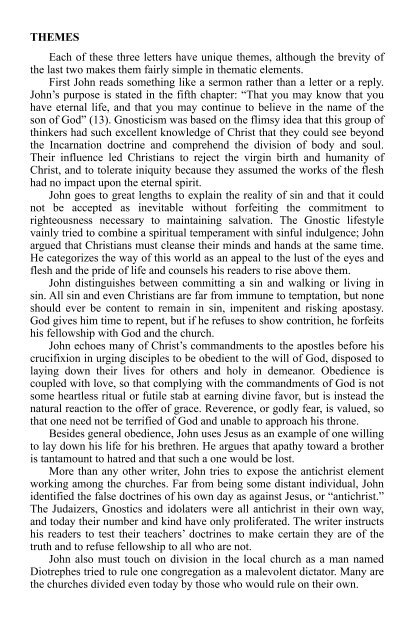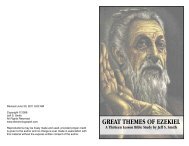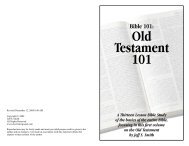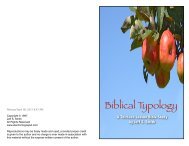New Testament Study Guides - ElectronicGospel
New Testament Study Guides - ElectronicGospel
New Testament Study Guides - ElectronicGospel
You also want an ePaper? Increase the reach of your titles
YUMPU automatically turns print PDFs into web optimized ePapers that Google loves.
THEMES<br />
Each of these three letters have unique themes, although the brevity of<br />
the last two makes them fairly simple in thematic elements.<br />
First John reads something like a sermon rather than a letter or a reply.<br />
John’s purpose is stated in the fifth chapter: “That you may know that you<br />
have eternal life, and that you may continue to believe in the name of the<br />
son of God” (13). Gnosticism was based on the flimsy idea that this group of<br />
thinkers had such excellent knowledge of Christ that they could see beyond<br />
the Incarnation doctrine and comprehend the division of body and soul.<br />
Their influence led Christians to reject the virgin birth and humanity of<br />
Christ, and to tolerate iniquity because they assumed the works of the flesh<br />
had no impact upon the eternal spirit.<br />
John goes to great lengths to explain the reality of sin and that it could<br />
not be accepted as inevitable without forfeiting the commitment to<br />
righteousness necessary to maintaining salvation. The Gnostic lifestyle<br />
vainly tried to combine a spiritual temperament with sinful indulgence; John<br />
argued that Christians must cleanse their minds and hands at the same time.<br />
He categorizes the way of this world as an appeal to the lust of the eyes and<br />
flesh and the pride of life and counsels his readers to rise above them.<br />
John distinguishes between committing a sin and walking or living in<br />
sin. All sin and even Christians are far from immune to temptation, but none<br />
should ever be content to remain in sin, impenitent and risking apostasy.<br />
God gives him time to repent, but if he refuses to show contrition, he forfeits<br />
his fellowship with God and the church.<br />
John echoes many of Christ’s commandments to the apostles before his<br />
crucifixion in urging disciples to be obedient to the will of God, disposed to<br />
laying down their lives for others and holy in demeanor. Obedience is<br />
coupled with love, so that complying with the commandments of God is not<br />
some heartless ritual or futile stab at earning divine favor, but is instead the<br />
natural reaction to the offer of grace. Reverence, or godly fear, is valued, so<br />
that one need not be terrified of God and unable to approach his throne.<br />
Besides general obedience, John uses Jesus as an example of one willing<br />
to lay down his life for his brethren. He argues that apathy toward a brother<br />
is tantamount to hatred and that such a one would be lost.<br />
More than any other writer, John tries to expose the antichrist element<br />
working among the churches. Far from being some distant individual, John<br />
identified the false doctrines of his own day as against Jesus, or “antichrist.”<br />
The Judaizers, Gnostics and idolaters were all antichrist in their own way,<br />
and today their number and kind have only proliferated. The writer instructs<br />
his readers to test their teachers’ doctrines to make certain they are of the<br />
truth and to refuse fellowship to all who are not.<br />
John also must touch on division in the local church as a man named<br />
Diotrephes tried to rule one congregation as a malevolent dictator. Many are<br />
the churches divided even today by those who would rule on their own.









